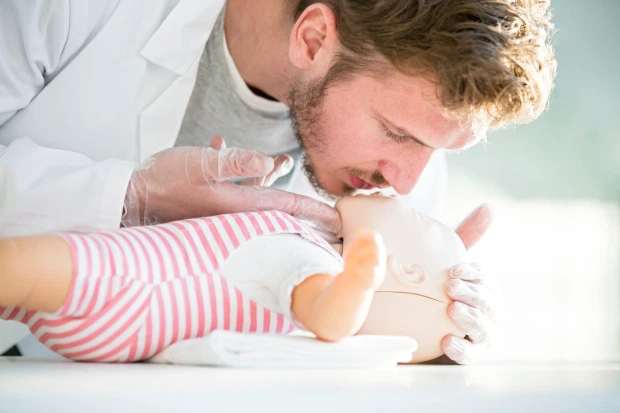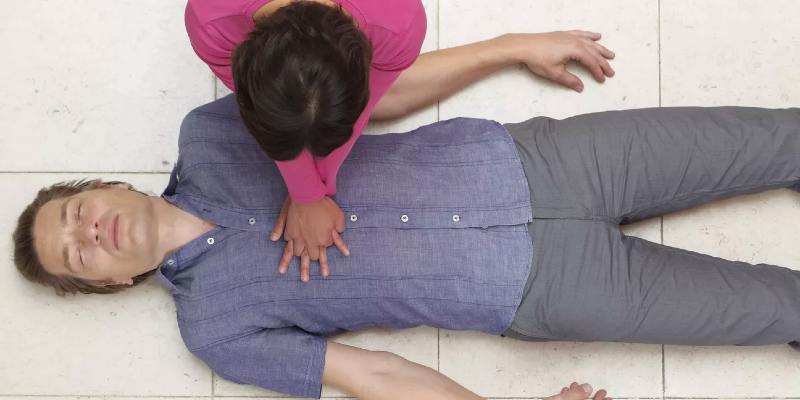Step-by-step guide on how to give CPR to adults, children and babies, with explanation of risks and emergency procedures.
Find more health guides, tips and advice
Resuscitation is the resuscitation of a person after respiratory and circulatory arrest. For this purpose, chest compressions, ventilation and other measures for circulatory support are carried out. Doctors also speak of cardiopulmonary resuscitation (CPR). Read here how to proceed and what you should pay attention to!
- CONTENTS
- How to give CPR: Brief overview
- How does resuscitation work?
- When do I do a resuscitation?
- Risks of resuscitation
How to give CPR: Brief overview
- What does resuscitation mean? Resuscitation measures in the event of respiratory and cardiac arrest.
- Procedure: Check whether the patient is reacting and breathing, making an emergency call, performing chest compressions and ventilation until the rescue service arrives or the patient is breathing again.
- In what cases? Resuscitation always takes place when vital organs are not adequately supplied with oxygen, e.g. B. with cardiac arrest or with insufficient pumping capacity of the heart.
- Risks: Broken ribs and injury to internal organs (such as the spleen ) during chest compressions, air and blood influx between the pleura and pleura, (low) risk of infection for the first aid worker (through mouth-to-mouth resuscitation of a patient with an infectious disease).
Danger!
- In an emergency, do not hesitate to start chest compressions (with enough pressure on the person’s chest) – it can be life-saving!
- The person affected can choke on vomit or on their own tongue. Therefore, check whether the (upper) airways are free: stretch your head backwards, lift your chin and pull it forward, remove foreign objects from your mouth and throat if possible.
- The physical strain during resuscitation can injure you as a first aider. There is a certain risk of contagion with resuscitation if the patient is infected.
How does resuscitation work?
Resuscitation essentially consists of chest compressions and mouth-to-mouth resuscitation. It is designed to ensure the oxygen supply to the brain and other organs when someone has suffered a respiratory / cardiovascular arrest . Speed is of the essence – a lack of oxygen in the brain can cause irreversible damage and death after just three minutes.
Basic measures of resuscitation
The basic measures are summarized under the term “basic life support” (BLS for short). They can and should also be carried out by laypeople. It includes:
- Talk to the patient and check his response
- Check breathing
- Call the emergency services
- CPR Chest compressions
- Mouth-to-mouth resuscitation
- if available: use an automated external defibrillator (AED) (defibrillation attempts to use electrical impulses to end life-threatening cardiac arrhythmias and restore a normal heart rhythm)
With the help of these measures, even a layperson can ensure that the heart and brain of the person concerned are adequately supplied with blood until the emergency doctor arrives .
Advanced measures
The extended resuscitation measures (“advanced life support”, or ALS for short) are carried out by medically trained personnel, such as paramedics. These try to animate the patient’s heart to a normal beating rhythm again. This is done through defibrillation and medication.
In addition, the airways are secured and venous access is established. During this time, the basic resuscitation measures (cardiac pressure massage and ventilation) are carried out continuously.
How to give CPR: what to do first
Anyone who finds a motionless person should, to the best of their knowledge, immediately provide first aid and resuscitation (as long as they do not endanger themselves).
1. Check awareness and breathing
As a first responder, you should first check whether the unconscious person responds to shaking or speaking loudly. Then check your breathing. To do this, stretch the patient’s head back slightly and lift his chin. Look for foreign objects in the mouth and throat that could impede breathing. Remove them if possible.
Hold your ear close to the unconscious person’s mouth and nose, facing towards the chest. Check to see if you can hear breath sounds, feel a breath of air, and see if the patient’s chest rises and falls.
2. Alert the emergency services
Call the emergency ambulance or ask bystanders to do so.
3. How to give CPR: Chest compression steps for CPR
Then start immediately with chest compressions, the core of resuscitation. It ensures that the oxygen-saturated blood present in the body is transported on to the cells (especially in the brain) despite respiratory and cardiovascular arrest. How to perform chest compressions:
- Lay the motionless person flat on a hard surface and expose their upper body .
- Kneeling to the side, place the heel of your hand on the middle of the breastbone, place the second hand on the first and interlace your fingers.
- In order to compress the chest sufficiently deeply, bend vertically over the chest (your shoulders should be perpendicular over your hands) and press down on the chest with rhythmic force with straight arms. The frequency should be at least 100 impacts per minute . You can also increase the heart rate pressure (up to a maximum of 120). Since “100” is a very abstract value, the following tip helps to find the right rhythm: Think of the song “Stayin ‘Alive” by the Bee Gees – its rhythm is ideal for chest compressions. The same goes for Justin Timberlake’s song “Rock Your Body”.
- After 30 compressions, there is twice a donation of breath, i.e. mouth-to-mouth or mouth-to-nose resuscitation .
- Continue this 30: 2 cycle until help arrives. If another first aider is present, it makes sense to change after every 30: 2 cycle (the chest compressions are exhausting!).
- If you do not trust yourself to ventilate (and no bystanders either), limit yourself to chest compressions and continue doing it continuously – until the emergency doctor arrives or the patient is breathing normally again.
- Use an automated external defibrillator (AED) if available . Such devices are now available at many central locations and in public buildings. Voice instructions help with correct application. Caution: The use of an automated external defibrillator must never delay or replace chest compressions!
As soon as the emergency services arrive, they will try to restore the patient to a natural heart rhythm. The patient is intubated to secure the airway. That means: You push a thin tube (tube) through your mouth or nose and into your windpipe. In addition, a venous access is established through which the patient can be given fluids and medication. Often, for example, adrenaline (raises and supports blood pressure) as well as anti-arrhythmic drugs (antiarrhythmics) are given. In addition, an EKG is done to check cardiac activity.
How to give CPR resuscitation in babies and children

As with adults, resuscitation in children includes chest compressions and resuscitation. If done in good time, it can save the life of the child in the event of a respiratory or circulatory arrest! Find out here how to proceed with resuscitation of children and the differences between resuscitation in adults!
Brief overview
- Procedure: Check whether the child is reacting and breathing, make an emergency call. If pulse and breathing are absent, perform chest compressions and rescue breathing until emergency services arrive or the child is breathing alone again.
- Special features: The frequency of chest compressions should be slightly higher for children (120 / min) than for adults (100 / min). In addition, experienced helpers are recommended a 15: 2 cycle (15 chest compressions and 2 alternating breaths) instead of the 30: 2 cycle as used in adults. In babies, only two fingers are used for chest compressions. Breathing is given to babies and young children through the mouth and nose at the same time.
- Risks: Chest compressions can break ribs and injure internal organs.
Danger!
- Objects that are swallowed are often the reason why children can no longer breathe. Check your mouth and throat to see if you can see anything.
- Never shake an unconscious / non-breathing child, especially a baby! You could seriously injure it by doing so.
- To clear the airways, do not overextend the child’s head too far or, in the case of babies, not at all, otherwise the airways will narrow.
- Alert the rescue service as soon as possible!
How to give CPR resuscitation: baby or child up to 12 months old
- Check reaction : Check whether the baby is reacting, preferably with a slight pain stimulus. For example, you can gently pinch the baby’s inside of the upper arm.
- Supine position : Lay the baby flat on its back, preferably on a hard surface (such as the floor).
- Head in neutral position : Bring the baby’s head into a normal, i.e. neutral position (do not overstretch!).
- Check breathing : Hold the baby’s chin with two fingers. Then, with the airways open, place your ears over the baby’s mouth and nose so that you can hear any breathing sounds. While listening, direct your gaze to the child’s chest in order to recognize any breathing movements.
- 5 x respiratory donation at the beginning : If the baby is not breathing or breathing properly or you are unsure about it, you should ventilate it immediately, through your mouth and nose at the same time: Start with five breaths.
- 15 x chest compressions: After the five breaths, place two fingers in the middle of the baby’s sternum and press them down, but no deeper than 2 to 4 centimeters. Repeat this 15 times at a frequency of about 120 per minute (to do this, press on the baby’s sternum about twice per second). So it is recommended for experienced helpers. Untrained helpers who are only familiar with resuscitation of adults can possibly also perform chest compressions 30 times, as is recommended for adults.
- Alternating breath donation and chest compressions : Donate breath twice more before you do another chest compressions (experienced helpers: 15 times; untrained helpers possibly 30 times). Continue this 15: 2 cycle (or 30: 2 cycle) until either the emergency doctor arrives or the baby breathes on its own again. In the second case , if they are still unconscious, move them to the stable side position .
The emergency doctor should be alerted as quickly as possible! Ask someone present to call 911 while you begin the baby’s resuscitation. If you are alone with the child, call emergency services after resuscitating the baby for about a minute. Immediately resume CPR resuscitatation after the call.
How to give CPR resuscitation: child (from one year)
Cardiopulmonary resuscitation (chest compressions and ventilation ) in children from one year of age is similar:
- Open airways and check breathing : Do this as you would with babies. However, if you are a child over the age of one, you can easily stretch your head.
- 5 x respiratory donation at the beginning : start ventilation (as with babies) with five breaths. Give your breath through the mouth and nose at the same time for young children and through the mouth or nose for older children.
- 15 x chest compressions : Perform chest compressions 15 times (as an untrained helper, possibly 30 times) by pressing rhythmically with the ball of your hand on the center of the child’s chest. As with babies, a frequency of about 120 per minute is recommended, i.e. about twice per second.
- Alternating respiratory donation and chest compressions : alternate between resuscitation and chest compressions. Experienced helpers, like medical staff, should adhere to the 15: 2 cycle (15 chest compressions and 2 alternations). Untrained helpers can also use the 30: 2 cycle known from adult resuscitation. Do not stop resuscitation until the ambulance arrives or the child begins to breathe again. In the second case, you should put the child in the stable side position if they are still unconscious.
When do I do a CPR resuscitation?
Cardiopulmonary resuscitation is always necessary if, in an acute emergency, vital organs or organ systems of an affected person are not adequately supplied with oxygen. The reason for this is usually cardiac arrest or insufficient pumping of the heart muscle, for example in the case of a heart attack , cardiac arrhythmia or pericardial tamponade (fluid accumulation in the pericardium that compresses the heart).
External influences such as suffocation, poisoning or drowning can also lead to cardiac arrest.
Typical symptoms of insufficient oxygen supply are unconsciousness, respiratory arrest or gasping (uncontrolled diaphragmatic twitching) and a missing or too fast heartbeat.
Risks of resuscitation
Resuscitation carries the following risks for the person concerned :
- Broken ribs
- Lung injuries
- Tears in the diaphragm, liver, or spleen
- Inhalation of stomach contents
- Entry of air into the pleural space ( pneumothorax )
- Entry of blood into the pleural space (hemothorax)
- Entry of blood into the space between the heart and the pericardium (hematopericardium)
There are also certain risks for the first aider : if he breathes a patient with an infection, there is a (low) risk of infection. Chest compressions can also be exhausting; the first aider may even injure himself.
Despite these potential risks for the patient and for you as the first aider, you should not shy away from resuscitation in an emergency – the life of the person concerned may depend on you!




